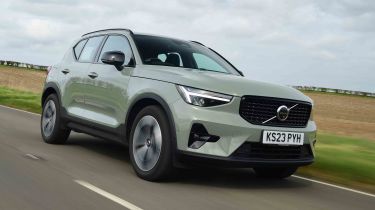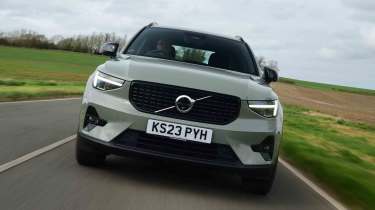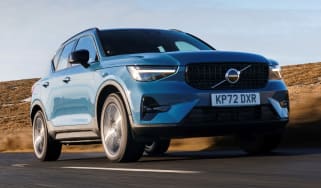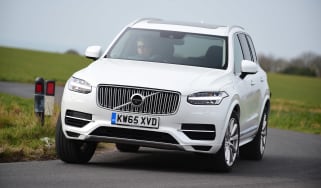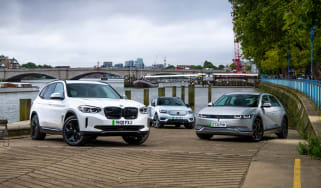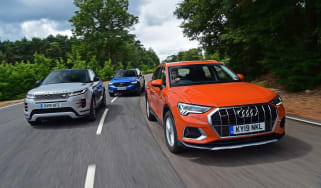Volvo XC40 review
The Volvo XC40 is a comfortable and stylish small SUV with some pleasing practical touches

Is the Volvo XC40 a good car?
There are plenty of contenders in the small premium SUV sector, and the Volvo XC40 is a decent choice. It’s not sensational to drive, but it strikes a decent blend of comfort and cruising refinement, all while offering lots of kerb appeal in a small-car package.
Add in a funky cabin design, a capable (albeit small-screened) infotainment system, plus Volvo's traditional focus on safety, and it's hard not to see the attraction of the XC40 as one of the most accomplished compact SUVs in the premium sector. The range has been whittled down in recent years, with plug-in hybrid power no longer offered and the all-electric XC40 now a standalone model rebadged as the EX40.
About the Volvo XC40
The XC40 is the smallest combustion-engined Volvo SUV, although the company now offers the even smaller electric Volvo EX30, too. The Volvo EX40 is the electric version of the XC40, after Volvo rebranded the XC40 Recharge to bring it into line with the EX30 and large Volvo EX90 electric SUV. For now, the XC40 continues alongside the larger Volvo XC60 and seven-seat Volvo XC90.
All versions of the XC40 are front-wheel drive – if you want four-wheel drive, you’ll have to pick the all-electric (and, sadly, more expensive) EX40 Twin Motor model. As well as only driving the front wheels, the XC40 is also sold exclusively with a seven-speed automatic gearbox.
Volvo XC40 prices and latest deals
How much does the Volvo XC40 cost? Well, official ‘on the road’ prices range from £36,560 to £47,020 but you can currently save an average of £1,666 through the Auto Express Find A Car service, where prices start at £35,840. You can lease a Volvo XC40 from £363 per month or buy a used model at prices starting from £11,295.
Check out our latest new car deals, leasing deals and used car deals for the top offers available now on Auto Express. And don't forget we can help you sell your car, too.
Engines, performance & drive
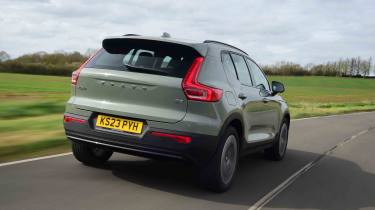
Pros |
|
Cons |
|
The Volvo XC40 was the first model to use the firm’s Compact Modular Architecture (CMA) underpinnings. This features MacPherson strut front suspension and a multi-link rear axle, which is similar to what you will find under its German rivals. However, if you’re after dynamic sparkle from a compact SUV, you’ll be better off looking elsewhere.
Performance, 0-60mph acceleration and top speed
The XC40 is offered with two mild-hybrid petrol engines, both of which power the front wheels via a seven-speed automatic gearbox. The B3 four-cylinder produces 161bhp and 265Nm of torque, and manages to cover the 0-62mph dash in 8.6 seconds.
Used - available now
The B4 model is based on the same 1,969cc in-line four as the B3, but power is increased to 194bhp, and there’s 300Nm of torque. This trims a full second off the sprint time at 7.6 seconds. All engines are electronically limited to a top speed of 112mph, in line with the rest of the Volvo line-up.
| Model | Power | 0-62mph | Top speed |
| XC40 B3 | 161bhp | 8.6 seconds | 112mph |
| XC40 B4 | 194bhp | 7.6 seconds | 112mph |
Town driving, visibility and parking
The XC40 strikes a nice balance between composure and comfort that’ll appeal to most buyers of small SUVs. It can get caught out on pockmarked and potholed city streets, particularly at low speeds and on larger wheels. We expect a Core model on 18-inch wheels to demonstrate a bit more compliance in this regard, because Ultra models fitted with 20-inch alloy wheels feel firm on typically bumpy UK roads.
Light steering means that the XC40 is easy to steer around a tight car park, while a high driving position with good visibility, standard front and rear parking sensors, and a reversing camera all help you to identify obstacles. A 360-degree camera system is available for £545, or as standard on Plus Pro trim and above.
Country road driving and handling
It wouldn’t be unreasonable to expect such a generally wafty small SUV to be boat-like in corners, but the XC40 stays composed, even when required to perform a sudden, rapid change of direction. It’s not as involving as the sharper X1, but it performs admirably well for a tall SUV with a relatively short wheelbase.
Volvo offers manual control of the automatic gearbox, but in practice, it’s a very fiddly system to use. There aren’t any shift paddles behind the steering wheel, which leaves you with the stubby drive selector. Rather than moving it back and forth to change gear, it moves from side to side - away from you to change up, towards you to change down - and isn’t very intuitive.
Motorway driving and long-distance comfort
The XC40 does a good job of soaking up road imperfections at high speeds, where the chassis deals with more flowing undulations well, but sharper bumps can still be jarring, whereas a BMW X1 smothers imperfections a little more adeptly. You’ll occasionally notice a slight floating effect, but it never strays to the point of making you seasick. Refinement is good, with wind and road noise well suppressed.
“Like all new Volvos, the XC40 is limited to a top speed of 112mph for safety reasons. That’s unlikely to be an issue in the UK, given our 70mph maximum speed limit, and would only bother anyone using unrestricted sections of the German Autobahn network.” - Max Adams, online reviews editor
MPG, emissions & running costs

Pros |
|
Cons |
|
The Volvo XC40 engine line-up is made up of two petrol units that come with a modest level of mild-hybrid assistance to help boost fuel efficiency. It does this by adding a little bit of electric power to the engine when accelerating to reduce overall consumption, but it can’t drive the car using electric power alone like a traditional hybrid car, so it doesn’t have the fuel efficiency or low CO2 emissions of full hybrid or plug-in hybrid rivals. Stop-start is included to help boost efficiency in town, too.
Both the B3 and B4 petrol units in the XC40 have matching combined fuel economy figures of 42.1mpg – although that may be affected by which trim level you choose, wheel size and, of course, how you drive. During our testing of a B3 petrol, we got close to that number because we saw a test economy figure of 41.5mpg, so at least that combined result is somewhat achievable in the real world.
| Model | MPG | CO2 | Insurance group |
| XC40 B3 Core | 42.1mpg | 150g/km | 23 |
| XC40 B4 Core | 42.1mpg | 149g/km | 26 |
Electric range, battery life and charge time
The Volvo XC40 is available in all-electric form under the name Volvo EX40, sitting above the smaller Volvo EX30 and below the bigger Volvo EX90. It can be had in two- or four-wheel-drive forms and has a range of 296 miles for the least expensive single-motor version with the smallest-capacity battery, to 355 miles for the single-motor extended-range version with the largest-capacity battery and most efficient drivetrain. You can read more about this version in our dedicated Volvo EX40 review by following the link provided.
Insurance groups
Insurance groups for the XC40 range from 23 to 30, depending on trim level and engine power, with the B4 sitting two groups higher than the same car with the B3 unit. That compares favourably with the BMW X1, which starts in group 25 for the 20i version, before going up to group 31 for the 23i model.
Tax
The entry-level XC40 Core and the Plus model powered by the B3 engine both dip below the £40,000 threshold for the luxury car road tax supplement that’s payable in years two to six, so they offer decent savings over the rest of the range while still being generously equipped.
Company car taxation is high because of the petrol CO2 emissions the XC40’s powerplants make. The range starts in the 34 per cent bracket for the 2024/25 tax year and increases from there. If you’re a company car user who’s tempted by the XC40, then the all-electric Volvo EX40 is the obvious alternative to choose.
Depreciation
Volvo is currently on the crest of a wave in terms of customer demand. When you also factor in the strong desirability within the premium SUV market, it's no surprise that the XC40 has strong residual values: between 54 and 60 per cent for mild-hybrid petrol models. The best is the B3 Core, while the worst is the B4 Ultra.
That’s a little better than its fellow premium small SUV rival, the BMW X1, which is expected to maintain between 50 to 55 per cent of its original value.
To get an accurate valuation on a specific Volvo XC40 model, check out our free car valuation tool...
Interior, design & technology
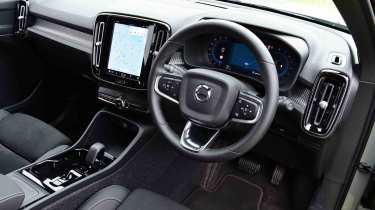
Pros |
|
Cons |
|
The Volvo XC40 was revealed in 2017, but even today it still stands out as a smart-looking compact SUV when compared with its rivals. Volvo deliberately penned it to have a different look when compared with its larger Volvo XC60 and Volvo XC90 siblings.
A subtle update in 2022 added a new front bumper, slightly slimmer LED headlights and a rear bumper that lacks the exhaust cut-outs you'll find on earlier examples of XC40, but otherwise left the overall design untouched.
Interior and dashboard design
Inside, there’s not a great deal in the way of opulence, and yet the XC40 still manages to deliver a dose of Swedish cool. There’s little in the way of clutter, and although the actual amount of space isn’t any greater than the class average, a variety of neat, practical touches make the XC40 feel a lot more ‘real-world liveable’ than many of its rivals.
The XC40 gets a nine-inch portrait-layout infotainment display, as well as a 12.3-inch digital instrument panel instead of conventional dials. The latter looks good and can be made to display a map, which is useful when following instructions from the built-in sat-nav, but it’s nowhere near as configurable as the Audi Virtual Cockpit system, or as easy to use.
The central infotainment display is less impressive, especially compared with the crisp-looking OLED display found in the MINI Countryman. The Countryman also has a wider variety of bright interior colours, with the XC40 looking a bit sombre in comparison. Plus and Plus Pro trims have charcoal upholstery, so you’ll have to choose the entry-level Core and select the light-grey seat fabric, or spring for the top-of-the-range Ultra and pick the cream-coloured synthetic leather option to get something a little brighter.
Materials and build quality
There are plenty of hard plastics in the cabin, but some of them come in handy, such as the plastic panels on the front seat backs, which make them more resistant to kicks. What isn’t finished with conventional plastic has piano black trim, and while it all feels well built and gives a premium ambience, we wonder how the material will look after a few years of use, when it has succumbed to scratches and marks.
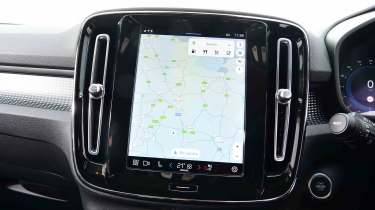
Infotainment, sat-nav and stereo
As part of our infotainment group test, we tested Volvo’s Google Android Automotive based infotainment system in the closely related Volvo EC40 – the coupe electric SUV version of the XC40. Both share the same relatively small nine-inch portrait-oriented screen, making comparisons possible.
We liked the positioning of the screen within easy reach of the driver and having the climate control settings on permanent display along the bottom of the screen. However, they take up valuable space on a rather small display, so some of the app ‘buttons’ have been shrunk in order to fit, which isn’t ideal for ease of use while driving.
We do like the clarity of the layout, which is typical Swedish minimalism, and resulted in the least distracted lap time. The software running the display seems to be on the ball when it comes to accessing the swipe down menu at the top of the screen, and the Google-based navigation and voice recognition work well when plotting your destination. Our creative director, Darren Wilson, ran an EC40 as part of a long-term test and often used the car’s in-built sat nav because of its ease of use and ability to use live traffic data to plot better routes and find available charging stations along his route.
Smartphone connectivity is a little behind rivals in that it is wired rather than wireless, but it all worked well on the day. Despite not having wireless connectivity, you do get wireless phone charging as standard.
The standard 250-watt, eight-speaker system provides decent sound quality, while the top-of-the-range Ultra comes with an upgraded 600-watt, 12-speaker Harman Kardon set-up, which is excellent.
“I definitely prefer the vertical screen, especially when it comes to the maps, because you can see more of where you’re going. I think that it makes for a better user experience. I found using the system was very straightforward, and the graphics and design help make it extremely simple to use. Everything’s well separated, too.” - Victoria Croquet, UX web developer
Boot space, comfort & practicality
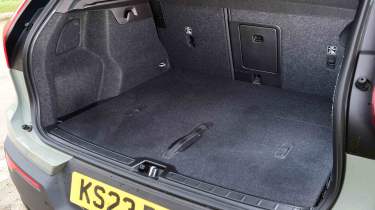
Pros |
|
Cons |
|
The Volvo XC40 has been created for a class where style and image traditionally take priority over outright space. The interior is neat, functional, and very Swedish in its design philosophy.
There are plenty of clever touches, too. There’s a folding hook in the glovebox for hanging bags from, while the flimsy-looking lidded compartment between the front seats is removable and can be washed. The capacity of the door bins is huge, which is helped by Volvo’s decision to arrange the speakers on the dashboard instead of in the doors.
Dimensions and size
The Volvo XC40 is 4,440mm long, 1,938mm wide (excluding side mirrors) and 1,652mm tall. That makes it a little shorter than the latest BMW X1 and Audi Q3, but it’s wider and taller than both of those rivals, which boosts space in the cabin.
| Dimensions comparison | |||
| Model | Volvo XC40 | Audi Q3 | BMW X1 |
| Length | 4,440mm | 4,531mm | 4,500mm |
| Width | 1,938mm (2,034mm inc mirrors) | 2,087mm (inc mirrors) | 1,845mm (2,104mm inc mirrors) |
| Height | 1,657mm | 1,588mm | 1,642mm |
| Wheelbase | 2,702mm | 2,681mm | 2,692mm |
| Boot space | 443-1,432 litres | 488-1,386 litres (375-1,293 litres PHEV) | 500-1,545 litres |
Seats & passenger space
You'll be disappointed if you expect the XC40 to provide a cavernous cabin. However, there’s plenty of space for two adults up front, and the tall driving position for a good view of your surroundings, and the relatively high roof adds to the sense of space inside. All versions come with very comfortable front seats with four-way electrically adjustable lumbar support and adjustable under thigh support. Plus trim upgrades the driver’s seat with electric adjustment with memory settings.
You’ll be able to fit a couple of grown-ups in the back seats easily. The XC40 has a pretty long wheelbase, so they should be fine for legroom, and there’s plenty of headroom, even with the optional panoramic sunroof fitted.
You can fit three across the back at a push, but there’s a transmission tunnel running down the middle of the floor - a remnant of the time when Volvo offered four-wheel drive in the XC40 - so middle-seat occupants might complain about having to place their feet on either side of it. Two Isofix child seat mounting points are provided on the outer positions of the rear seats.
Boot space
The XC40's 443-litre boot isn't the largest load bay in its class, but it’s easy to use the space available. That’s because the mild-hybrid version's boot has an impressively flat floor, with no lip at the front edge, making it easy to slide heavier items in there. Even more importantly, the rear seats fold down completely flat, so you get a level load bay and 1,319 litres of space at your disposal, although we would prefer it if, like the Audi Q3 and BMW X1, it came with a more versatile 40/20/40 split folding rear bench. The electric EX40, which uses the same platform as the XC40, has a slightly smaller boot to make room for the drive battery.
The Convenience Pack includes a folding boot floor that divides the space, and provides a way to stop items rolling around. The hinges even stand proud of the top edge of the resulting divider, giving you a few extra points from which to hang shopping bags.
Towing
Towing capacities for the XC40 vary depending on which engine you choose. The mild-hybrid B3 has a 1,600kg maximum braked trailer weight, but buyers prioritising towing ability will be better served by the more powerful B4, which is not only torquier but has a 2,000kg braked limit. A retractable towbar is priced at around £1,400.
“The boot is a good shape – I squeezed a tumble dryer in there – and there’s room under the floor for things like wellies and wet clothes.” - Richard Ingram, deputy editor
Reliability & safety

Pros |
|
Cons |
|
The Volvo XC40 finished 37th out of 50 cars in the 2025 Driver Power owner satisfaction survey, while the Volvo brand came 13th out of 31 in the manufacturers poll. Owners praised the practicality, ride comfort and number of safety features above all else, but weren’t so complimentary about driving pleasure or value for money.
Volvo is a byword for safety, and the XC40’s credentials don't disappoint. It scored five stars out of five when tested by Euro NCAP in 2018, and its score was updated in 2021 with the arrival of the electric version (now EX40). The XC40 scored an impressive 97 per cent for adult occupant protection and 87 per cent for child occupant protection. You get automatic emergency braking across the range, and it’s capable of spotting cars, pedestrians, and large animals. Every XC40 gets a lane departure system, which will intervene and pull the car back into the lane if it senses you’re going to steer into the path of oncoming traffic.
Volvo’s Pilot Assist semi-autonomous driving tech is standard on Ultra models and an option on other trims in the range. Simply engage cruise control in stop-start traffic, and the car’s software will manage driving inputs, such as steering to stay in lane and accelerating and braking to keep pace with surrounding traffic. The system can even bring the car to a complete halt if necessary.
| Euro NCAP safety ratings | |
| Euro NCAP safety rating | Five stars (2021) |
| Adult occupant protection | 97% |
| Child occupant protection | 87% |
| Vulnerable road user protection | 71% |
| Safety assist | 76% |
Buying and owning
Best buy: Volvo XC40 B3 Core
Given how the XC40 ranked near the bottom (49th out of 50) in terms of value for money in the 2025 Driver Power customer satisfaction survey, we’d recommend sticking with the least expensive B3 Core version to get the best bang for your buck.
The B3 petrol engine is quick enough for most needs, while entry-level Core comes with luxuries and safety equipment you’d need in a family car, whilst also keeping the list price well under the £40,000 luxury car tax surcharge limit.
Volvo XC40 alternatives
The XC40 remains a popular choice with small SUV buyers looking for something a little more premium, but it has been usurped in our rankings by the likes of newer rivals such as the MINI Countryman and BMW X1.
The BMW X1 has a wider choice of engines than the XC40, including diesel and a plug-in hybrid options that might suit some company car and long distance drivers more than the XC40. It also has the edge on the XC40 in terms of driving dynamics.
The MINI Countryman has a fresher design and a more colourful interior with a bit more character. Being based on the BMW X1, it too is fun to drive, and we’re impressed with the amount of interior space it has.
Deals on the Volvo XC40 and alternatives
Volvo XC40 Owner Reviews
Below is what owners thought of the Volvo XC40 in the 2024 Driver Power customer satisfaction survey.
What they like |
What they don't like |
| “I love the quiet, smooth and effortless progress in EV mode, but I’m reassured by the fitment of an engine.” | “Too many features are buried in the touchscreen sub-menus. I probably still haven’t found some!” |
| “It looks stylish and modern, and it just screams quality both inside and out. It’s also easy and enjoyable to drive.” | “The worst aspect is the petrol engine/auto gearbox pairing, which is so jerky it’s almost uncomfortable.” |
| “The safety systems are very comprehensive and I’m especially happy with the auto emergency braking.” | “The LED headlights are incredibly disappointing. My old 2016 Mercedes’ lights were miles better.” |
| “The XC40 feels like a class product, with a high-quality cabin and an effortless and refined driving experience.” | “I pride myself on being a smooth driver, but it’s really difficult to modulate the brakes, which lack bite.” |
| “Looks as good after three years as at delivery. Soft-touch plastics and supple leather feel high in quality.” | “Economy is disappointing, given the hybrid tech fitted. And it costs more to service than my Porsche.” |
| “It’s not cheap, but the price is competitive with similarly high-quality products, so I don’t feel short-changed.” | |
| “The handing is generally excellent. There is very little body roll, but the stiffer suspension does mean that severe potholes and rough road surfaces are more noticeable.” | |
| “The front seats are supportive, with lots of adjustment, while the excellent all-round visibility is reassuring. I’m quite small, so being slightly higher up makes driving that bit easier.” | |
| “I can easily fit four six-footers in the car with no complaints. Despite the roomy cabin, there’s also plenty of space in the boot, which is better than most rivals offer, and this is boosted by the loads of handy storage below the boot floor.” |
Volvo XC40 pictures
Frequently Asked Questions
The XC40 comes with a three-year/60,000-mile warranty, which is par for the course in this class, but the likes of the Alfa Romeo Tonale and BMW X1 offer unlimited-mileage coverage for the same period. As with most rival brands, Volvo offers extended warranties at extra cost. For the XC40, you can extend the coverage for another 12 months with the same mileage limit, or increase it to 80,000 miles for a bit more.

